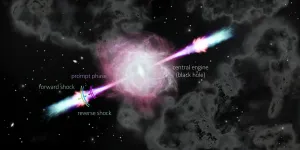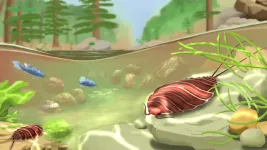(Press-News.org) Do you like the thick brush strokes and soft color palettes of an impressionist painting such as those by Claude Monet? Or do you prefer the bold colors and abstract shapes of a Rothko? Individual art tastes have a certain mystique to them, but now a new Caltech study shows that a simple computer program can accurately predict which paintings a person will like.
The new study, appearing in the journal Nature Human Behaviour, utilized Amazon's crowdsourcing platform Mechanical Turk to enlist more than 1,500 volunteers to rate paintings in the genres of impressionism, cubism, abstract, and color field. The volunteers' answers were fed into a computer program and then, after this training period, the computer could predict the volunteers' art preferences much better than would happen by chance.
"I used to think the evaluation of art was personal and subjective, so I was surprised by this result," says lead author Kiyohito Iigaya, a postdoctoral scholar who works in the laboratory of Caltech professor of psychology John O'Doherty.
The findings not only demonstrated that computers can make these predictions but also led to a new understanding about how people judge art.
"The main point is that we are gaining an insight into the mechanism that people use to make aesthetic judgments," says O'Doherty. "That is, that people appear to use elementary image features and combine over them. That's a first step to understanding how the process works."
In the study, the team programmed the computer to break a painting's visual attributes down into what they called low-level features--traits like contrast, saturation, and hue--as well as high-level features, which require human judgment and include traits such as whether the painting is dynamic or still.
"The computer program then estimates how much a specific feature is taken into account when making a decision about how much to like a particular piece of art," explains Iigaya. "Both the low- and high-level features are combined together when making these decisions. Once the computer has estimated that, then it can successfully predict a person's liking for another previously unseen piece of art."
The researchers also discovered that the volunteers tended to cluster into three general categories: those who like paintings with real-life objects, such as an impressionist painting; those who like colorful abstract paintings, such as a Rothko; and those who like complex paintings, such as Picasso's cubist portraits. The majority of people fell into the first "real-life object" category. "Many people liked the impressionism paintings," says Iigaya.
What is more, the researchers found that they could also train a deep convolutional neural network (DCNN) to learn to predict the volunteer's art preferences with a similar level of accuracy. A DCNN is a type of machine-learning program, in which a computer is fed a series of training images so that it can learn to classify objects, such as cats versus dogs. These neural networks have units that are connected to each other like neurons in a brain. By changing the strength of the connection of one unit to another, the network can "learn."
In this case, the deep-learning approach did not include any of the selected low- or high-level visual features used in the first part of the study, so the computer had to "decide" what features to analyze on its own.
"In deep-neural-network models, we do not actually know exactly how the network is solving a particular task because the models learn by themselves much like real brains do," explains Iigaya. "It can be very mysterious, but when we looked inside the neural network, we were able to tell that it was constructing the same feature categories we selected ourselves." These results hint at the possibility that features used for determining aesthetic preference might emerge naturally in a brain-like architecture.
"We are now actively looking at whether this is indeed the case by looking at people's brains while they make these same types of decisions," says O'Doherty.
In another part of the study, the researchers also demonstrated that their simple computer program, which had already been trained on art preferences, could accurately predict which photos volunteers would like. They showed the volunteers photographs of swimming pools, food, and other scenes, and saw similar results to those involving paintings. Additionally, the researchers showed that reversing the order also worked: after first training volunteers on photos, they could use the program to accurately predict the subjects' art preferences.
While the computer program was successful at predicting the volunteers' art preferences, the researchers say there is still more to learn about the nuances that go into any one individual's taste.
"There are aspects of preferences unique for a given individual that we have not succeeded in explaining using this method," says O'Doherty. "This more idiosyncratic component may relate to semantic features, or the meaning of a painting, past experiences, and other individual personal traits that might influence valuation. It still may be possible to identify and learn about those features in a computer model, but to do so will involve a more detailed study of each individual's preferences in a way that may not generalize across individuals as we found here."
INFORMATION:
The study, titled, "Aesthetic preference for art can be predicted from a mixture of low- and high-level visual features," was funded by the National Institute of Mental Health (through Caltech's Conte Center for the Neurobiology of Social Decision Making), the National Institute on Drug Abuse, the Japan Society for Promotion of Science, the Swartz Foundation, the Suntory Foundation, and the William H. and Helen Lang Summer Undergraduate Research Fellowship. Other Caltech authors include Sanghyun Yi, Iman A. Wahle (BS '20), and Koranis Tanwisuth, who is now a graduate student at UC Berkeley.
Chatbots hold promise for dementia patient or caregiver support, but are still in their infancy, finds a paper published in the Journal of Medical Internet Research. None of the interactive digital apps tested by medical researchers and a computer scientist performed well on all testing criteria, and all the apps contained linguistic biases and usability challenges. The authors conclude that until developers produce evidence-based chatbots that have undergone end user evaluation it will be hard to evaluate their potential to adequately educate and support dementia patients and their caregivers.
"Dementia care is complex and no two cases of dementia are alike. Chatbots have the potential of providing ...
Ozone is a pollutant at ground level, but very high in the atmosphere's "ozone layer," it absorbs damaging ultraviolet radiation. Past studies have examined ozone levels in the Southern Hemisphere, but little is known about levels of the molecule in Antarctica over long periods. Now, researchers reporting in ACS' Environmental Science & Technology have analyzed more than 25 years of Antarctic data, finding that concentrations near the ground arose from both natural and human-related sources.
Ozone gas has a sharp or acrid scent that sometimes accompanies smog or summer storms. It forms when sunlight ...
Microplastic pollution of waterways has become a huge concern, with the tiny pieces of plastic entering food webs and potentially having harmful effects on animals and people. In addition, microplastics can act as breeding grounds for antibiotic-resistant bacteria. Now, researchers reporting in Environmental Science & Technology have analyzed antibiotic-resistance genes (ARGs) on five types of microplastics at different locations along the Beilun River in China, finding much higher abundances in urban than rural regions.
In rivers, major sources of microplastics include textile fibers from laundering, water bottle fragments, and films from bags and wrappers. Also prevalent in ...
An international team of scientists, led by astrophysicists from the University of Bath in the UK, has measured the magnetic field in a far-off Gamma-Ray Burst, confirming for the first time a decades-long theoretical prediction - that the magnetic field in these blast waves becomes scrambled after the ejected material crashes into, and shocks, the surrounding medium.
Black holes are formed when massive stars (at least 40 times larger than our Sun) die in a catastrophic explosion that powers a blast wave. These extremely energetic events drive out material at velocities ...
Researchers using the Atacama Large Millimeter/submillimeter Array (ALMA) discovered a titanic galactic wind driven by a supermassive black hole 13.1 billion years ago. This is the earliest-yet-observed example of such a wind to date and is a telltale sign that huge black holes have a profound effect on the growth of galaxies from the very early history of the Universe.
At the center of many large galaxies hides a supermassive black hole that is millions to billions of times more massive than the Sun. Interestingly, the mass of the black hole is roughly proportional to the mass ...
The old cousins of the common woodlice were crawling on Irish land as long as 360 million years ago, according to new analysis of a fossil found in Kilkenny.
The research, published today (00.01 Wednesday 16 June) in the science journal Biology Letters, used state-of-the-art modern imaging technology to create a new picture of the Oxyuropoda - a land-based creature larger than the modern woodlice - using a fossil found in Kiltorcan, Co Kilkenny in 1908.
Lead researcher Dr Ninon Robin, a postdoctoral researcher at University College Cork's (UCC) School of Biological, Earth and Environmental Sciences said that their work advances science's understanding of when land-dwelling species of crustaceans roamed the earth, and what they looked like.
Dr Robin said:
"Woodlice, ...
Québec produces more strawberries than any other Canadian province. Strawberries are delicate and difficult to keep fresh. In response to this challenge, Monique Lacroix, a professor at at the Institut national de la recherche scientifique (INRS), and her team have developed a packaging film that can keep strawberries fresh for up to 12 days. The team's findings on how this film protects against mould and certain pathogenic bacteria have been published in Food Hydrocolloids.
The innovative film is made of chitosan, a natural molecule found in shellfish shells. This food industry by-product contains key antifungal properties ...
Thirty state-of-the-art IPCC-climate models predict dramatically different climates for the Northern Hemisphere, especially Europe. An analysis of the range of responses now reveals that the differences are mostly down to the individual model's simulations of changes to the North Atlantic ocean currents and not only - as normally assumed - atmospheric changes. The work, by Katinka Bellomo, National Research Council of Italy, Institute of Atmospheric Sciences and Climate, and colleagues is published today in Nature Communications and is part of the European ...
A study led by Fernando Colchero, University of Southern Denmark and Susan Alberts, Duke University, North Carolina, that included researchers from 42 institutions across 14 countries, provides new insights into the aging theory "the invariant rate of ageing hypothesis", which states that every species has a relatively fixed rate of aging.
- Human death is inevitable. No matter how many vitamins we take, how healthy our environment is or how much we exercise, we will eventually age and die, said Fernando Colchero.
He is an expert in applying statistics and mathematics to population biology and an associate professor at Department of Mathematics and Computer Science, University of Southern Denmark.
"We were able to shed light on the invariant rate of ageing hypothesis by combining ...
Teachers play a key role in supporting children's development in early childhood education classrooms such as Head Start. Research shows significant associations between teachers' depressive symptoms and their students' social and emotional development. However, little research has focused on the associations between teachers' depressive symptoms and academic outcomes of preschoolers from low-income families. Specifically, one important pathway that has not been examined is whether teacher depressive symptoms have implications for the quality of family-teacher relationships. This in turn could affect how supportive parents ...





